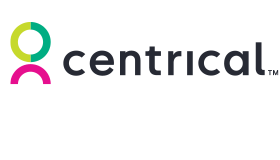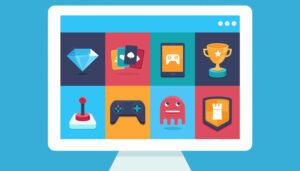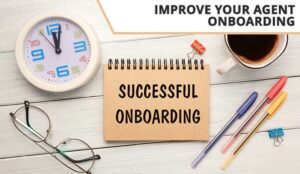First impressions can make or break the onboarding experience for new hires and highly influence their long-term success.
Given that contact centres experience high early attrition rates during the first 90 days, it should come as no surprise that companies are increasingly turning to innovative onboarding approaches like gamification to transform the mundane orientation process into an engaging and interactive experience.
Read on to discover some of the most effective strategies, implementation tips, and examples of successful applications that you can apply to your own employee onboarding.
What Is Onboarding Gamification?
Onboarding is the integration of game design and principles into the onboarding process. Gamification transforms the traditional onboarding experience into an interactive and enjoyable journey.
Elements such as leaderboards, progress bars, badges, quizzes, and incentives are strategically employed to make the onboarding process more engaging and motivating for new employees.
Why Use Gamification for Onboarding?
The onboarding process sets the foundation for an employee’s journey within a company. A well-structured onboarding program contributes to a smooth transition for new hires and higher retention rates and increased engagement.
However, traditional onboarding methods can often be monotonous and do not motivate modern employees who are used to a personalized, tech-infused experience in other areas of life.
This is where onboarding gamification can help. Leveraging game elements in the onboarding process not only makes it more enjoyable but also addresses key challenges.
For one, gamification enhances user engagement by tapping into intrinsic and extrinsic motivators to keep employees engaged in the process.
This transforms the onboarding experience from a passive process into an active and participatory one.
Onboarding gamification also helps accelerate time to proficiency, fight the forgetting curve, and boost knowledge retention by including elements such as quizzes and knowledge checks, with points, rewards, and progression when goals are mastered.
Gamification motivates employees to actively participate in the learning process, making them more likely to remember and apply the information effectively.
Gamified onboarding also often includes collaborative elements, such as employee contributions, that encourage interaction among new hires.
This fosters a sense of collaboration and community and helps in the early formation of professional relationships.
Plus, by incorporating gamification elements that align with the company’s values and culture, organizations can reinforce their identity as an employer of choice – which can help tremendously with both recruiting and retention efforts.
Finally, onboarding gamification allows new hires to track their progress through visual elements like progress bars and rankings.
This transparency provides a clear roadmap, reducing anxiety and enhancing the feeling of accomplishment.
5 Onboarding Gamification Strategies
There are many onboarding gamification strategies and best practices that organizations can implement. Below are five that we recommend:
1. Showing Progress
Implementing segmented leaderboards creates motivation and a sense of healthy competition among new hires.
By showcasing achievements and progress, individuals are motivated to strive for the top spot, fostering a culture of excellence and camaraderie.
2. Leveling Up
As new hires progress, they should “level up” and unlock new challenges, content, and rewards with each level.
This ongoing and gradual progression keeps employees invested in the onboarding journey and motivated to reach their goals and complete challenges.
3. Incentives and Rewards
Recognize and reward achievements with badges, certificates, or even tangible rewards. Incentives provide acknowledgment of effort and accomplishment, motivating employees to actively participate in the onboarding process.
4. Quizzes and Assessments
Integrate interactive quizzes and assessments to reinforce key information. This not only gauges the understanding of new hires but also adds an element of competition, making the learning process more engaging.
5. Add a Checklist
As new hires make progress on onboarding tasks and training, it helps to have something of a “done” list. This helps instill a sense of accomplishment, which helps drive further motivation and engagement.
Implementation Tips for Onboarding Gamification
Implementing onboarding gamification successfully requires careful planning and a robust change management program.
To start, you need to understand the people behind the screen, so be sure to tailor the gamification elements to resonate with your target audience.
Consider the demographics, preferences, and expectations of your new hires to create a personalized and relatable experience.
Ensuring that the gamification elements align with your company’s culture and values is another important aspect.
This reinforces the organizational identity and helps new hires understand the expectations and norms within your work environment.
You’ll also want to define clear goals for the gamified onboarding process – and tie gamification to these goals.
Whether it’s to facilitate learning, build a sense of community, or accelerate the adaptation process, establishing specific goals will guide the design and implementation.
And ensuring that the gamified onboarding platform is accessible across different devices and platforms is just as important.
Ultimately, you’re doing all of this for the benefit of your employees, so it’s important to know how engaged they really are.
Pro tip: Incorporate feedback mechanisms to understand the effectiveness of the gamified onboarding process. Regularly assess employee satisfaction, engagement levels, and learning outcomes to make data-driven improvements.
And remember: While competition can be motivating, it’s crucial to maintain a balance. Avoid creating an overly competitive environment that may lead to stress or discourage collaboration among new hires. Sort of defeats the purpose, right?
How to Measure Success for Onboarding Gamification
Measuring the success of onboarding gamification involves evaluating various key performance indicators (KPIs). Some essential metrics to consider include:
Retention Rates:
Track the retention rates of employees who underwent gamified onboarding compared to those who experienced traditional onboarding. Higher retention rates indicate the effectiveness of the gamification strategy.
Employee Engagement:
Assess the level of engagement by analyzing participation rates, completion times, and interactions within the gamified platform. Increased engagement suggests that the onboarding process resonates with employees.
Learning Outcomes:
Evaluate the effectiveness of the gamified learning approach by assessing knowledge retention and application. This can be done through quizzes, assessments, and on-the-job performance evaluations.
Feedback and Surveys:
Collect feedback from new users through surveys to understand their experience. Identify strengths, weaknesses, and areas for improvement to refine the gamification strategy.
Time to Productivity:
Measure the time it takes for new hires to become productive contributors to the team. A shorter onboarding period with gamification may indicate a more efficient adaptation process.
Summary and Key Takeaways
Employee retention matters. And providing an interactive onboarding solution can keep motivation and engagement flowing from the start of the employee journey. Here are the key takeaways for you to jot down:
- Onboarding gamification is an engagement and retention strategy that integrates game elements, mechanics, and design principles into the onboarding process.
- Smart strategies to consider implementing are leaderboards, the ability to “level up,” incentivizing goals, and providing knowledge checks and quizzes.
- KPIs: Tracking retention rates for those who took part in onboarding gamification versus those who didn’t; analyzing participation rates to view engagement; implementing quizzes to measure knowledge retention; garnering surveys to see what works and what doesn’t; and measuring time to productivity.
This blog post has been re-published by kind permission of Centrical – View the Original Article
For more information about Centrical - visit the Centrical Website
Call Centre Helper is not responsible for the content of these guest blog posts. The opinions expressed in this article are those of the author, and do not necessarily reflect those of Call Centre Helper.
Author: Centrical
Published On: 1st Feb 2024 - Last modified: 6th Dec 2024
Read more about - Guest Blogs, Centrical






 Centrical provides a real-time performance management, microlearning, gamification, coaching, and voice of the employee platform for frontline teams. The solution inspires and personally guides employee success and growth by making every moment actionable.
Centrical provides a real-time performance management, microlearning, gamification, coaching, and voice of the employee platform for frontline teams. The solution inspires and personally guides employee success and growth by making every moment actionable. 




























